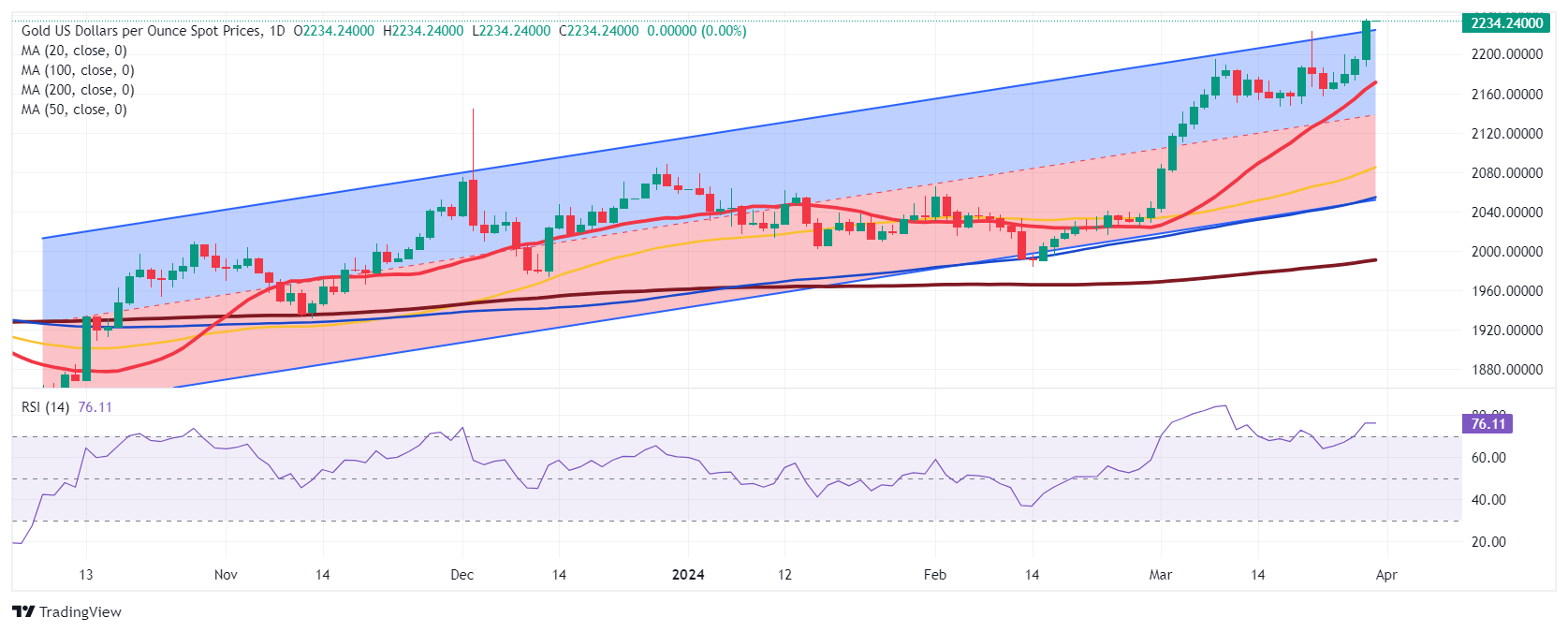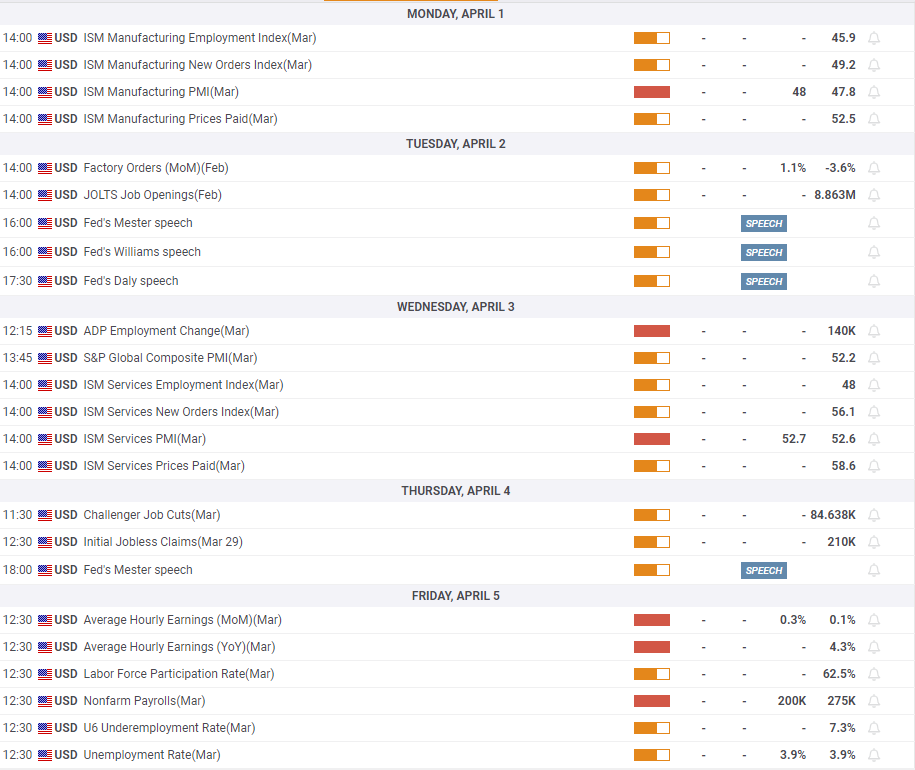- Gold came within a touching distance of a new all-time high.
- Technical overbought conditions could discourage buyers in the near term.
- US labor market data for March could drive XAU/USD’s action next week.
Gold ignored the persistent US Dollar (USD) strength this week and climbed above $2,200. As market focus shifts to next week’s key macroeconomic data releases from the US, XAU/USD’s technical outlook suggests that the pair could stage a technical correction before the next leg higher.
Gold price gains traction in holiday-shortened week
Following the impressive recovery seen in the second half of the previous week, the US Dollar (USD) Index, which tracks the USD’s performance against a basket of six major currencies, turned south at the beginning of the week and allowed XAU/USD to close in positive territory on Monday. Hawkish comments from Federal Reserve (Fed) officials, however, made it difficult for the pair to gather further bullish momentum. Atlanta Fed President Raphael Bostic said that he was expecting the US central bank to lower the policy rate one time this year and Fed Governor Lisa Cook added that there were risks to easing the policy “too much or too soon, as well as too late.”
Gold climbed to $2,200 during the European trading hours on Tuesday but reversed its direction in the second half of the day, with the upbeat data from the US helping the USD hold its ground. Durable Goods Orders in the US increased by 1.4% on a monthly basis in February following the 6.9% contraction recorded in January.
In the absence of fundamental drivers, Gold regained its traction and advanced above $2,200. Although hawkish comments from Fed Governor Christopher Waller supported the USD in the second half of the week, technical buyers refused to give up control while XAU/USD held above $2,200.
Waller noted that the Fed was not in a rush to lower the policy rate, arguing that it might be appropriate to hold the restrictive stance for longer than previously thought to help inflation return to the 2% target on a sustainable trajectory.
On Thursday, the Bureau of Economic Analysis (BEA) announced that the annualized real Gross Domestic Product (GDP) growth for the fourth quarter was revised higher to 3.4% from 3.2% in the previous estimate. Other US data showed that there were 210,000 Initial Jobless Claims in the week ending March 23.
Inflation in the US, as measured by the change in Personal Consumption Expenditures (PCE) Price Index, increased slightly to 2.5% on a yearly basis in February, data released by the US Bureau of Economic Analysis (BEA) showed Friday. The reading met the consensus forecast and followed January’s 2.4% increase. The Core PCE Price Index, which excludes volatile food and energy prices, rose at an annual pace of 2.8%, in line with market expectations.
Gold price faces a two-way risk next week
The US economic calendar will offer several high-tier data releases that could influence the market pricing of the Fed rate outlook and drive the XAU/USD action.
On Monday, the ISM will publish the Manufacturing PMI data for March. The headline PMI is forecast to edge slightly higher to 48. A reading above 50 could provide a boost to the USD with the immediate reaction. Investors will also pay close attention to the Prices Paid Index, the inflation component of the PMI survey. In January and February, the Prices Paid Index held above 50, after staying below that level for eight consecutive months. In case the inflation component retreats below 50 and points to a pullback in the manufacturing sector’s input prices, the USD could struggle to find demand even if the main PMI comes in better than expected.
On Tuesday, the Bureau of Labor Statistics (BLS) will publish the JOLTS Job Openings data for February. Unless this data diverges significantly from January’s print of 8.86 million, the market reaction is likely to remain muted.
The ADP Employment Change and the ISM Services PMI data will be featured in the US docket on Wednesday. A disappointing ADP data could cause markets to anticipate a weak jobs report on Friday and make it difficult for the USD to find demand. Later in the day, the market reaction to the Prices Paid Index of the Services PMI survey could resemble the reaction to Monday’s PMI report.
Finally, the BLS will release the highly-anticipated labor market report on Friday. Nonfarm Payrolls (NFP) are forecast to rise 200,000 in March following the 275,000 increase recorded in February. The Unemployment Rate is seen holding steady at 3.9%, while the monthly wage inflation, as measured by the change in the Average Hourly Earnings, is anticipated to rise to 0.3% on month from 0.1%.
Although the February NFP increase beat the market expectation by a wide margin, the USD came under selling pressure because January and December prints got revised lower. In case March NFP data comes in stronger than forecast and there are no noticeable revisions to the past readings, the USD could outperform its rivals and weigh on XAU/USD with the knee-jerk reaction. On the other hand, a weak NFP growth could hurt the USD. An upbeat NFP accompanied by downward revisions could not allow the USD to capitalize on the data.
The CME FedWatch Tool shows that markets are currently pricing in a nearly 40% probability that the Fed will leave the policy rate unchanged in June. If the jobs report highlights tightening conditions in the labor market, investors could refrain from betting on a rate cut in June and could even doubt that the Fed will lower the policy rate by a total 75 basis points this year even though that’s what the last Summary of Economic Projections suggested. In this scenario, XAU/USD could make a deep correction. In case the report keeps the expectations for a rate reduction in June by delivering a weak NFP, Gold could gather bullish momentum.
Gold technical outlook
The Relative Strength Index (RSI) indicator on the daily chart climbed above 70 and XAU/USD briefly surpassed the upper limit of the ascending regression channel coming from October, currently located near $2,220. Buyers could move to sidelines and wait for the pair to make a correction before deciding whether the rally has more legs. The 20-day Simple Moving Average (SMA) aligns as first support at $2,160 before $2,135 (mid-point of the ascending channel).
It’s not easy to set a bullish target for Gold but the round level at $2,300 could be the next resistance in case the precious metal holds above $2,220 and confirms that level as support.

Gold FAQs
Gold has played a key role in human’s history as it has been widely used as a store of value and medium of exchange. Currently, apart from its shine and usage for jewelry, the precious metal is widely seen as a safe-haven asset, meaning that it is considered a good investment during turbulent times. Gold is also widely seen as a hedge against inflation and against depreciating currencies as it doesn’t rely on any specific issuer or government.
Central banks are the biggest Gold holders. In their aim to support their currencies in turbulent times, central banks tend to diversify their reserves and buy Gold to improve the perceived strength of the economy and the currency. High Gold reserves can be a source of trust for a country’s solvency. Central banks added 1,136 tonnes of Gold worth around $70 billion to their reserves in 2022, according to data from the World Gold Council. This is the highest yearly purchase since records began. Central banks from emerging economies such as China, India and Turkey are quickly increasing their Gold reserves.
Gold has an inverse correlation with the US Dollar and US Treasuries, which are both major reserve and safe-haven assets. When the Dollar depreciates, Gold tends to rise, enabling investors and central banks to diversify their assets in turbulent times. Gold is also inversely correlated with risk assets. A rally in the stock market tends to weaken Gold price, while sell-offs in riskier markets tend to favor the precious metal.
The price can move due to a wide range of factors. Geopolitical instability or fears of a deep recession can quickly make Gold price escalate due to its safe-haven status. As a yield-less asset, Gold tends to rise with lower interest rates, while higher cost of money usually weighs down on the yellow metal. Still, most moves depend on how the US Dollar (USD) behaves as the asset is priced in dollars (XAU/USD). A strong Dollar tends to keep the price of Gold controlled, whereas a weaker Dollar is likely to push Gold prices up.
Information on these pages contains forward-looking statements that involve risks and uncertainties. Markets and instruments profiled on this page are for informational purposes only and should not in any way come across as a recommendation to buy or sell in these assets. You should do your own thorough research before making any investment decisions. FXStreet does not in any way guarantee that this information is free from mistakes, errors, or material misstatements. It also does not guarantee that this information is of a timely nature. Investing in Open Markets involves a great deal of risk, including the loss of all or a portion of your investment, as well as emotional distress. All risks, losses and costs associated with investing, including total loss of principal, are your responsibility. The views and opinions expressed in this article are those of the authors and do not necessarily reflect the official policy or position of FXStreet nor its advertisers. The author will not be held responsible for information that is found at the end of links posted on this page.
If not otherwise explicitly mentioned in the body of the article, at the time of writing, the author has no position in any stock mentioned in this article and no business relationship with any company mentioned. The author has not received compensation for writing this article, other than from FXStreet.
FXStreet and the author do not provide personalized recommendations. The author makes no representations as to the accuracy, completeness, or suitability of this information. FXStreet and the author will not be liable for any errors, omissions or any losses, injuries or damages arising from this information and its display or use. Errors and omissions excepted.
The author and FXStreet are not registered investment advisors and nothing in this article is intended to be investment advice.
Recommended Content
Editors’ Picks

Gold price jumps to fresh record high above $3,200 on US-China tariff war
Gold price sits at all-time highs of $3,219 in the Asian session on Friday. The weakening of the US Dollar and escalating trade war between the US and China provide some support to traditional safe haven asset Gold price amid increased dovish Fed expectations.

USD/JPY recovers losses in sync with US Dollar, retakes 143.50
USD/JPY is trimming losses to retest 143.50 in Asian trading hours on Friday, having tested levels under 143.00. The pair is tracking the US Dollar price action amid persistent trade jitters and US recession fears. The Fed-BoJ divergent policy expectations support the Japanese Yen, keep the weight intact on the pair.

AUD/USD consolidates weekly gains near 0.6250 despite trade tensions
AUD/USD consolidates weekly gains near 0.6250 in Asian trading on Friday. The pair capitalizes on sustained US Dollar weakness even as risk aversion remains at full steam on deepening US-China trade war. The White House confirmed on Thursdayt that the cumulative US tariffs on Chinese goods have risen to 145%.

Can Trump's tariff pause and declining inflation keep Bitcoin afloat? Experts weigh in
Bitcoin dived below $80,000 on Thursday despite US Consumer Price Index data coming in lower than expected and President Donald Trump's 90-day reciprocal tariffs pause on 75 countries.

Trump’s tariff pause sparks rally – What comes next?
Markets staged a dramatic reversal Wednesday, led by a 12% surge in the Nasdaq and strong gains across major indices, following President Trump’s unexpected decision to pause tariff escalation for non-retaliating trade partners.

The Best brokers to trade EUR/USD
SPONSORED Discover the top brokers for trading EUR/USD in 2025. Our list features brokers with competitive spreads, fast execution, and powerful platforms. Whether you're a beginner or an expert, find the right partner to navigate the dynamic Forex market.
